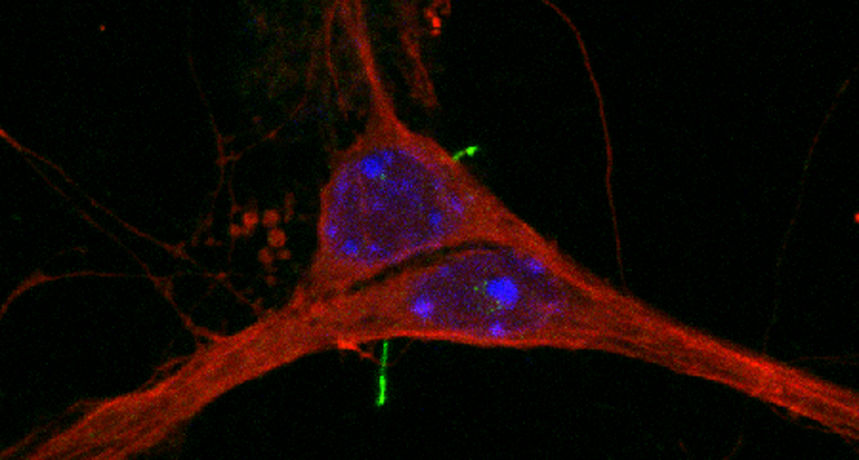Cilia in the brain may be busier than previously thought
The long-overlooked nerve cell appendage may help prevent obesity or aid communication among cells

COMING INTO THEIR OWN Mouse nerve cells (red) grown in a dish each sport a hairlike filament called a primary cilium (green), which may have many roles in the brain.
Ruchi Bansal and N. Berbari
- More than 2 years ago
Nerve cells in the brain make elaborate connections and exchange lightning-quick messages that captivate scientists. But these cells also sport simpler, hairlike protrusions called cilia. Long overlooked, the little stubs may actually have big jobs in the brain.
Researchers are turning up roles for nerve cell cilia in a variety of brain functions. In a region of the brain linked to appetite, for example, cilia appear to play a role in preventing obesity, researchers report January 8 in three studies in Nature Genetics. Cilia perched on nerve cells may also contribute to brain development, nerve cell communication and possibly even learning and memory, other research suggests.
“Perhaps every neuron in the brain possesses cilia, and most neuroscientists don’t know they’re there,” says Kirk Mykytyn, a cell biologist at Ohio State University College of Medicine in Columbus. “There’s a big disconnect there.”
Most cells in the body — including those in the brain — possess what’s called a primary cilium, made up of lipid molecules and proteins. The functions these appendages perform in parts of the body are starting to come into focus (SN: 11/3/12, p. 16). Cilia in the nose, for example, detect smell molecules, and cilia on rod and cone cells in the eye help with vision. But cilia in the brain are more mysterious.
The new research offers some clarity. In one study, molecular geneticist Christian Vaisse of the University of California, San Francisco, and colleagues studied mutations in a protein called MC4R that are known to cause severe obesity in people. Experiments on mice showed that MC4R normally resides within the cilia on appetite-controlling nerve cells. But several of these mutations prevented MC4R from reaching those cells’ cilia from elsewhere in the cells, experiments on cells in dishes showed. And one of these mutations prevented MC4R from reaching nerve cell cilia in the brains of mice.
When the researchers interfered with ADCY3, a protein in the cilia that helps MC4R regulate appetite, the resulting mice became obese. Those results suggest that MC4R must reach the cilia in order to interact with ADCY3 and work properly. In the other two papers, scientists link the ADCY3 gene to obesity in people, providing more evidence that cilia are involved in obesity.
Story continues after graphic
Double team
Proteins called ADCY3 (red; yellow arrows for emphasis) and MC4R (green) can be found in the primary cilia of nerve cells (nuclei are blue) known to be involved in appetite control. Together, the proteins (yellow in composite image) may be involved in obesity.

That link has already been found in rare cases. Mutations that affect cilia can cause severe obesity, as seen with diseases such as Bardet-Biedl syndrome. But the new results hint that abnormal cilia may be more widely involved in obesity. Earlier genetic studies have tied obesity to the MC4R gene, which the mouse study now shows to be important in cilia. It’s possible that many of the common genetic obesity culprits may actually be tinkering with the primary cilia, Vaisse says.
It’s not yet clear why the MC4R protein needs to reach the cilia to control appetite, Mykytyn says. It’s possible that the appendages possess the right mix of helper proteins that aid MC4R in its job. Or cilia might change the way the protein works, allowing it to be more efficient.
Although many questions remain, the new study “opens up the window a little more” on what cilia actually do in the brain, how they function — and what can happen when they don’t, says Nick Berbari, a cell biologist at Indiana University-Purdue University Indianapolis.
It’s possible that cilia have even broader roles in memory, learning and perhaps mental health, Berbari says. Mice without normal cilia in parts of their brain had trouble remembering a painful shock and recognizing familiar objects, he and colleagues reported in PLOS One in 2014. Though speculative, impaired cilia signaling may even be involved in disorders such as depression and schizophrenia, the researchers wrote in that study.
Other brain functions are getting assigned to cilia, too. Mykytyn and his colleagues have found a protein in cilia that detects the chemical messenger dopamine, a signal that helps certain nerve cells operate. And like the obesity-related MC4R protein, this dopamine detector needs to be on a cilium to work properly.
Cilia may be capable of much more than acting as little antennae that sense signals outside of nerve cells. The stubby appendages may actually be able to send messages themselves, results from a 2014 study in Current Biology suggest. There, scientists reported that nerve cell cilia in C. elegans worms could float little packets containing chemical messages into the space between cells. Those signals may have a role in the worms’ behavior, the researchers suspect.
Examining the various roles of cilia in the brain is tough, Mykytyn says. There is no simple way to separate cilia from the rest of cells’ outer membranes. The challenges are greater with elaborate nerve cells, where cilia can be relatively small.
But advances in microscopy and genetic tricks that can allow scientists to manipulate specific aspects of cilia may reveal more about how these “underappreciated appendages” work, Berbari says — even in places as mysterious as the brain.






